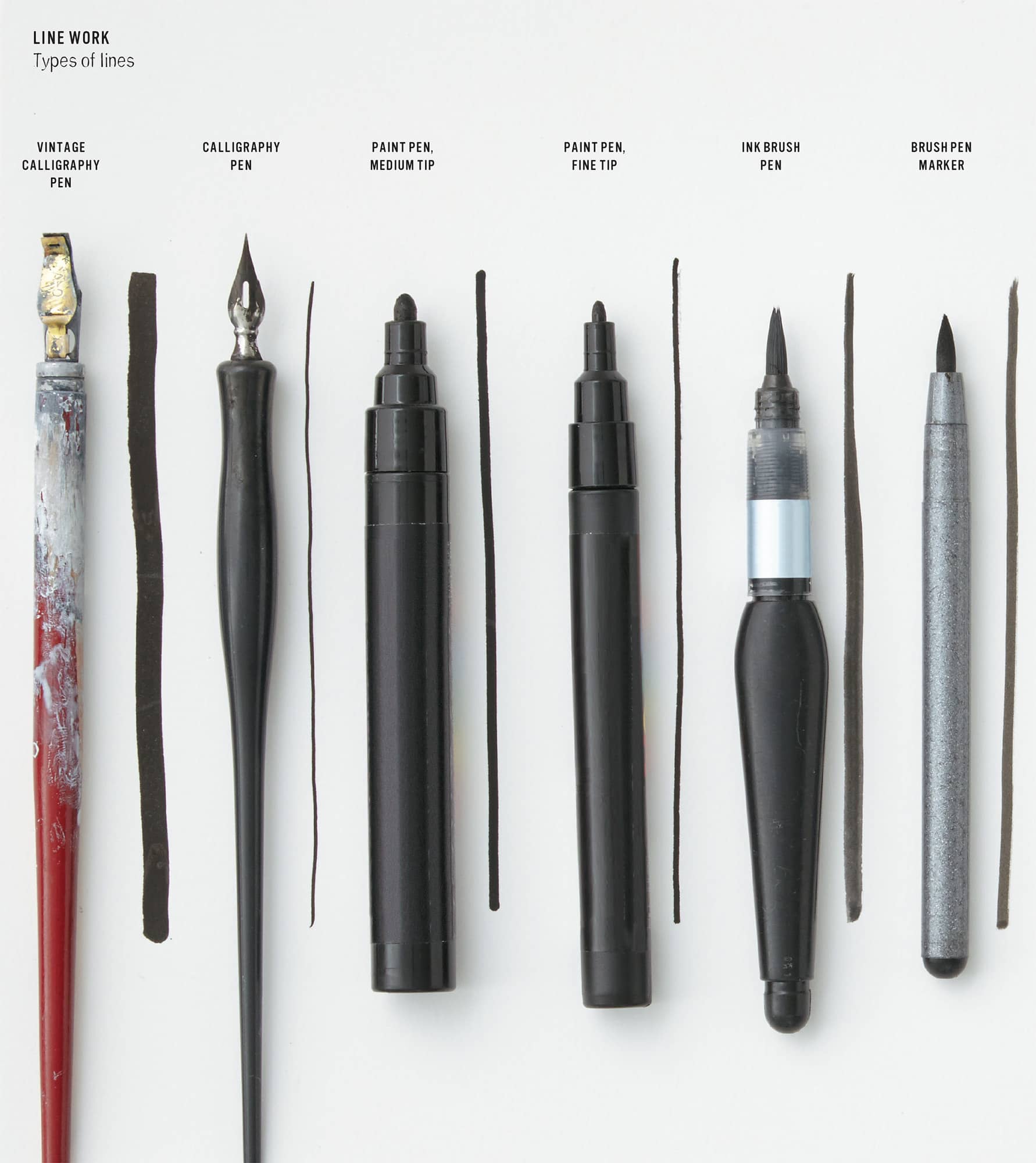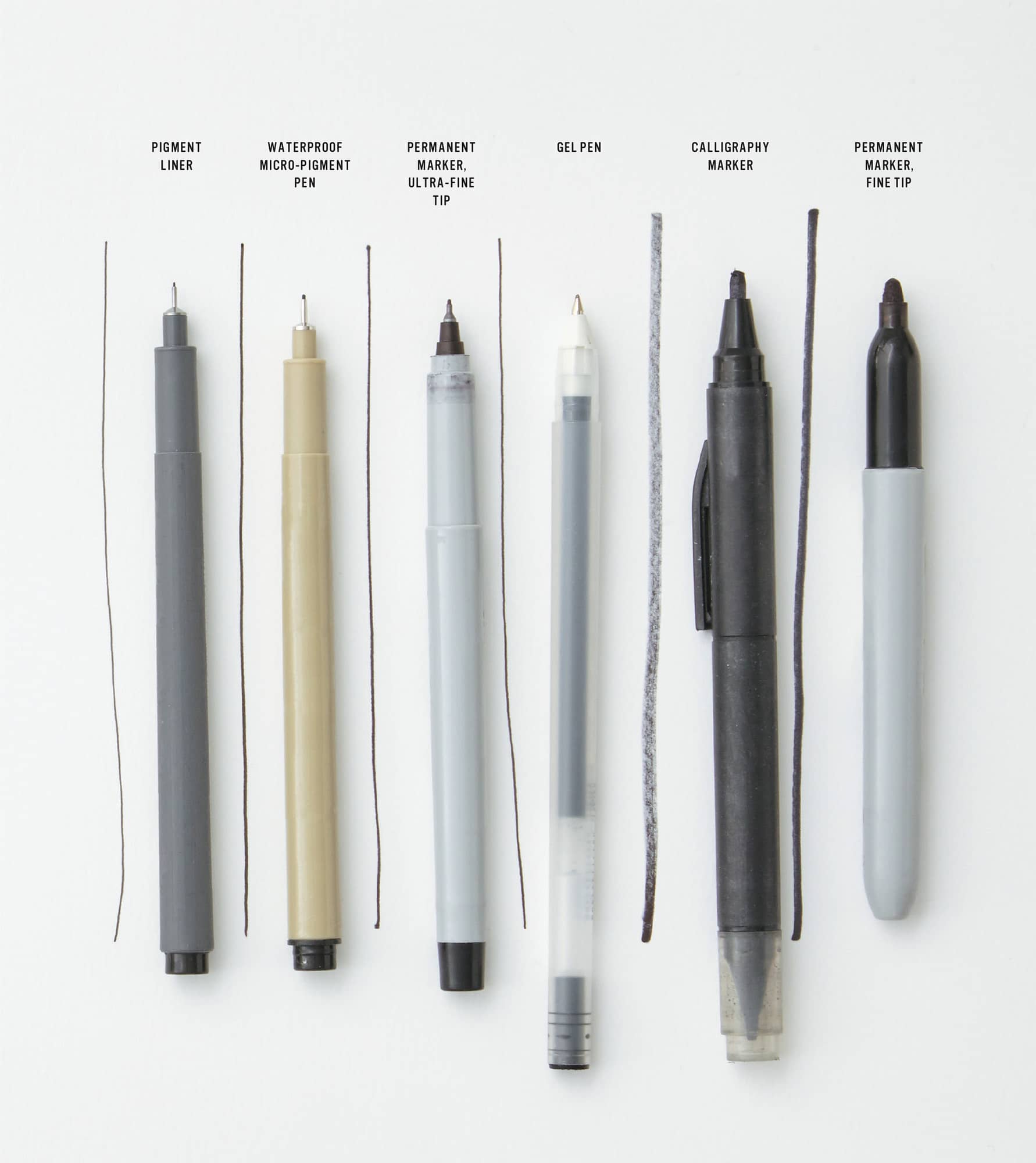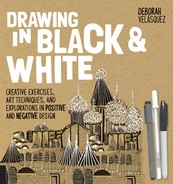MATERIALS

Your first task as you dive into this book is to get familiar with your materials. Set out all of your supplies and try each pen, each brush, and each paper type. Get ready to have your materials teach you. Practice making marks and scribbles with each pen. Do the same on different papers. Then repeat this exercise using a couple of different brushes and watercolor or gouache. Notice how the tools move with the papers. Notice how heavy or light the marks are. For example, I learned that it is easier to draw a straight line by pushing away from you with your pen or brush. I also learned that it is easier to make a circle with a nice edge by pulling your pen or brush toward you.
WHAT SHOULD I DRAW ON?
Papers are made from the fibers of either wood pulp or cotton. Lower quality papers are made from wood pulp. Higher quality papers are made from cotton fibers that are more resistant to chemical breakdown over time. These papers are commonly referred to as “rag” paper. Many medium-grade papers are a combination of both.
Many of the projects in this book can be executed with multiple types of paper. If you just want to get started and only have printer paper on hand, that is perfectly suitable. Ideally, get some cardstock and some medium- and heavier-weight papers for drawing, and particularly when you get to the exercises that use paint. You will notice that different surfaces affect the type of marks you get. Your artwork deserves a good foundation, and you may enjoy the process more when you use nicer papers.
PRINTER PAPER or regular weight is great as scrap and for testing prints, line work, and drawing.
DRAWING PAPER, often part wood and part paper pulp, is a bit heavier than printer paper. It is available in white, black, and other neutrals, such as tans, browns, and grays.
CARDSTOCK (also called cover stock) is thicker and more durable than printer paper. Cardstock is easy to cut and work with and has a nice smooth surface for drawing.
SCRAPBOOKING PAPER offers smooth and textured surfaces for drawing and comes in weights suitable for stamping and water media.
BROWN CRAFT PAPER is a nice complement to black-and-white line or paint work and offers a rustic beauty.
Save SCRAP PAPER, DISCARDED BITS FROM PROJECTS, AND PAPER BAGS. Use them to test paint or line strokes, and to remove excess paint from brushes before stenciling. Always use scrap paper to get the flow going in your drawing implement as well as in your drawing hand, and warm up with a few scribbles and doodles before you start on your exercise.
ARCHIVAL PAPER is the highest quality acid-free paper and best for artwork that you want to last a long time.
WATERCOLOR PAPER is absorbent and is best for wet media. It is available in different weights and in three finishes, typically labeled as “rough,” “cold press,” and “hot press.” Most artists prefer the textured finish of rough or cold press for transparent watercolors, because the texture helps control the paint. The smoother finish of hot press paper is desirable for opaque watercolors, for more detailed paint work, and for printmaking and drawing.
BRISTOL BOARD OR BRISTOL PAPER is a quality, heavier-weight paper, similar to cardstock and smooth for stamping and line work. It is typically acid free and is available in white, black, and various colors.
MIXED-MEDIA PAPERS AND BOARDS are ordinary papers that have been coated or primed, so they can accept almost any medium. They are suitable for water-based paints, inks, gouache, and more.
DECIDING WHAT IS RIGHT FOR YOU
Try different papers and see what feels best to you. I enjoy the smoothness of cardstock for line work and flat, even, ink stamp impressions. I like the sturdiness and absorbent nature of the heavier stock or watercolor paper for painting. Mixed-media paper and Bristol board/paper serve both purposes. Cardstock is great for collage making, cutting, and gluing.
Lighter-weight papers work well for sketching in pencil, pen, and marker, as well as for stamping. I like how cardstock feels in my hand, and I like that I can draw and paint on it without worrying about cost.
PAINTS AND INKS
INDIA INK is simple black-colored ink used for drawing with Sumi brushes or with calligraphy pens.
ACRYLIC INK is water resistant, dries quickly, and flows easily. It can be used for stamping as well. It has a translucent shine when dry.
BLOCK PRINTING INK is a rich, quick-drying, water-based ink used for rubber and linoleum block printing.
PIGMENT INK PADS are used for stamping carved block designs onto paper. They have a rich and vivid ink that dries on top of the paper, as opposed to soaking through, but takes longer to dry than dye-based inks.
GOUACHE is opaque watercolor paint with a velvety finish. It has a creamy yogurt consistency when mixed and is not waterproof. I have worked with this medium my whole creative career and it is, by far, my favorite. It is forgiving and versatile, and it dries fast as well. Dried gouache on your palette can be revived with a drop of water, so there is no waste! Darker colors get lighter when dry, and lighter colors dry darker. One note: Gouache can crack when dry, so do not fold or roll artwork made with this medium; store it flat.
PENS, PENCILS, AND BRUSHES
CALLIGRAPHY PENS can be fitted with various nibs that offer a variety of line weights. They are a great vehicle for mark making. I love my vintage calligraphy pen; I feel it has some history.
WATERPROOF MICRO-PIGMENT PENS are archival waterproof marking pens. They are great for drawing, don’t bleed, and can be found in a variety of tip sizes.
PERMANENT MARKING PENS are waterproof but can occasionally bleed a little and are found in a variety of tip sizes.
PAINT PENS are opaque and water-based ink markers that dry to a matte finish.
GEL PENS are smooth-rolling ink pens for detail work.
BRUSH PENS create a brush-like, watercolor effect by a controlled flow from the well to the nib and can be used with ink and paint. They are easy to handle and transportable.
PENCILS are available in both soft and hard leads for drawing and shading.
BRUSHES come in a variety of sizes and shapes. We will be using a round, a pointed round, a flat, and a mop brush for our exercises. I like to use sable brushes. Always use an inexpensive brush for mixing paint.
SUMI BRUSHES are used for Chinese calligraphy and drawing and can be used with ink or gouache. Working with a Sumi brush is magical to me. I love to move the paint with expressive brushstrokes on paper to create written beauty. The magic lies in the parts of the brush tip, which allow thick to thin lines in the same fluid stroke.
ART BRUSHES are used to clear working surfaces of eraser residue and to brush off cut strips and residue from rubber blocks after carving.
PENS FOR MARK MAKING

BLOCK PRINTING TOOLS
RUBBER CARVING BLOCKS come in white, gray, or pink rubber, much like eraser material. They are soft and offer a smoother cut when working with your tools. I prefer the thick, white blocks, which are easier to handle and less prone to tearing.
LINOLEUM BLOCKS provide a harder surface and are better for detail work.
A LINOLEUM CUTTER WITH INTERCHANGEABLE TIPS cuts rubber or linoleum blocks for printing. Tips 1 and 2 are for thin lines, tips 3 and 4 are for medium lines, and tip 5 is for cutting away large pieces. Cutting tools with wooden handles can be found with tips attached individually.
BRAYERS come in rubber or foam and are used for rolling paint onto carved blocks, for stenciling, and for mixing paint. I use the rubber type to warm paint by rolling it onto plexiglass for stenciling and block-printing exercises.
PLEXIGLASS makes a nice flat palette for painting and is a perfect top plate for distributing even pressure onto carved blocks for uniform impressions when printing.
A BONE FOLDER is used to rub on the wrong side of a drawing to transfer the image to a block. A wooden spoon also works for this.
SOFT LEAD PENCILS are for drawing on rubber blocks or transferring lines of artwork onto tracing paper, essentially making your own carbon transfer sheet.
TRACING PAPER is used for drawing and transferring line work from your design onto your rubber block. Remember that the image that is cut into the rubber block will print in reverse. Carbon paper may be used as well.
OTHER SUPPLIES
PALETTES provide a surface to mix and hold paint as you create. They come in a variety of sizes and designs, from metal to acrylic, so find a few to suit your needs. Some paints need convex wells for mixing, so small ceramic bowls are great for this, or invest in a metal or plastic palette with convex wells. Use old plates, sushi soy sauce holders, or small ceramic bowls with ridges to lay your brushes on as I do.
ARTIST TAPE has a secure hold but is repositionable and easy to remove without harming your artwork.
SCISSORS are used for cutting tasks.
A CRAFT KNIFE is great for cutting borders and shapes in a precise manner.
A CUTTING MAT protects your surface and is self-healing. The guidelines printed on the mat are a great help for cutting stencils and rubber blocks.
A METAL RULER doubles as a straightedge for cutting with a craft knife.
A SEE-THROUGH PLASTIC RULER is used for measuring and inking precise line work.
A METAL PALETTE KNIFE is helpful for mixing and scooping paint onto a palette. You can also use a plastic knife, a spoon, or a popsicle stick.
NEWSPAPER OR LARGE CRAFT PAPER is great for covering your inking and painting surfaces.
DECOUPAGE OR GEL MEDIUM is used as glue for collage work.


